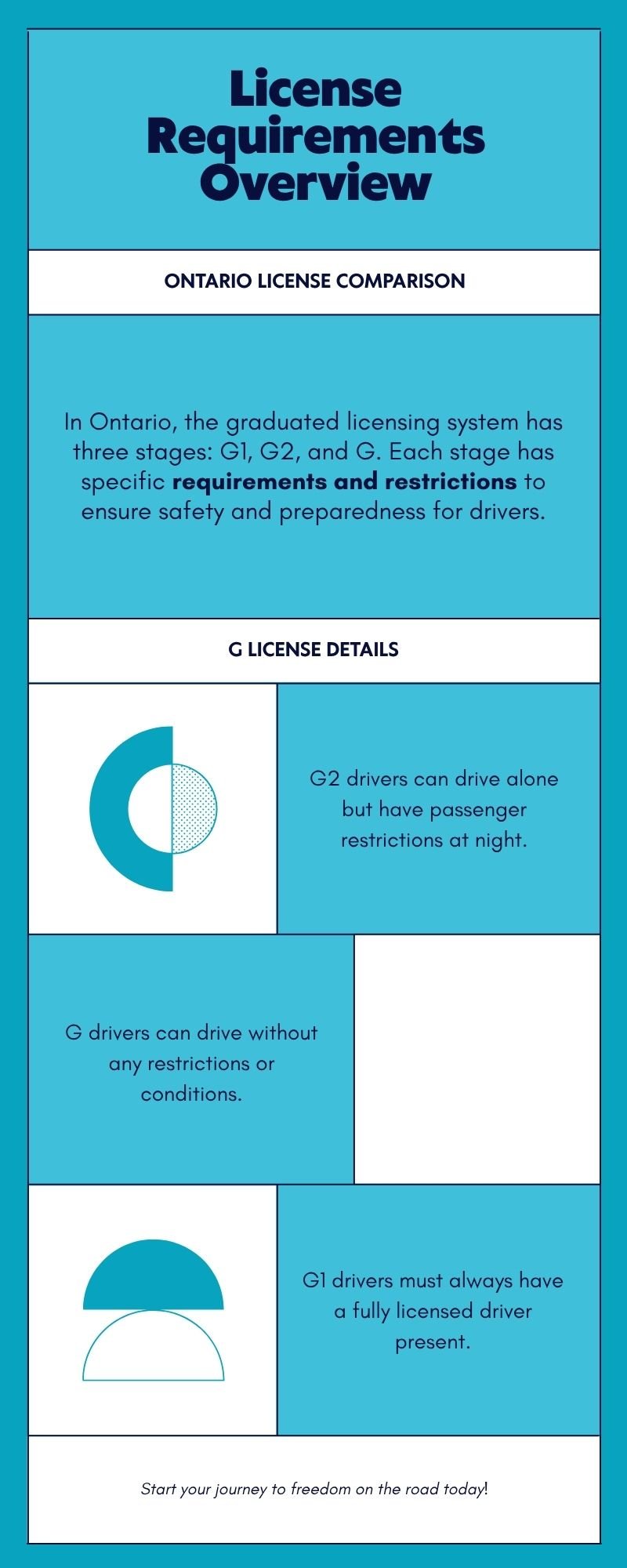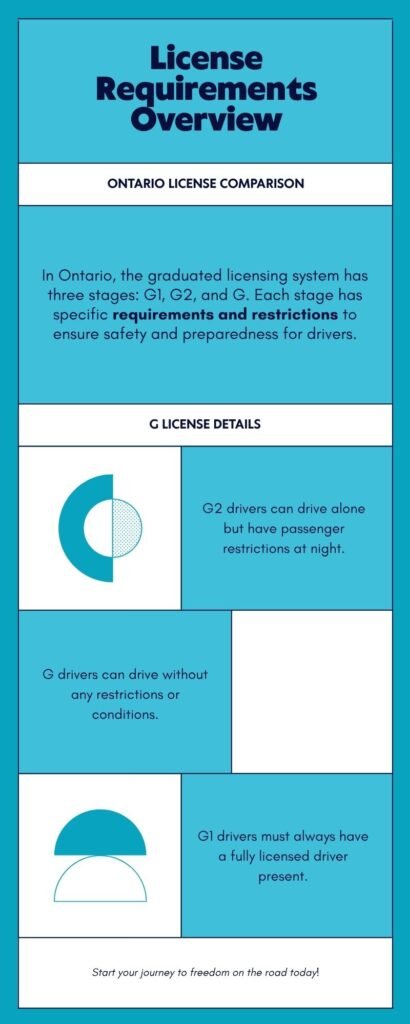

Ontario G1 vs G2 vs G License Comparison

Overview of Ontario’s Graduated Licensing System
Ontario’s GLS, implemented in 1994, aims to enhance road safety by allowing new drivers to develop skills gradually under controlled conditions. The system consists of three levels: G1 (learner’s permit), G2 (probationary license), and G (full license). Each stage has specific eligibility criteria, restrictions, and tests to ensure drivers gain experience before achieving full driving privileges. The entire process typically takes 20–24 months.
G1 License: The Learner’s Permit
Eligibility
- Minimum age: 16
- Must pass a vision test
- Must pass a written knowledge test (40 multiple-choice questions on road rules and signs, based on the Official MTO Driver’s Handbook)
- Provide valid identification (e.g., passport, birth certificate)
Test Details
- Written Knowledge Test: Assesses understanding of traffic laws, road signs, and safe driving practices. Cost: $159.75 (includes the test and a 5-year license fee).
- Vision Test: Ensures adequate vision for safe driving.
Restrictions
- Must be accompanied by a fully licensed driver with at least 4 years of experience, seated in the front passenger seat.
- Accompanying driver must have a blood alcohol concentration (BAC) of less than 0.05% (or 0% if under 21).
- No driving on 400-series highways or high-speed expressways (e.g., QEW, Don Valley Parkway) unless with a licensed driving instructor.
- No driving between midnight and 5 a.m.
- Zero BAC and THC for the driver.
- All passengers must wear seatbelts, and the number of passengers is limited to the number of working seatbelts.
- No handheld electronic devices (harsher penalties for violations compared to G drivers).
Duration
- Minimum 12 months, reduced to 8 months with a government-approved driver education course.
- Valid for 5 years; if not upgraded to G2, the process restarts.
G2 License: The Probationary License
Eligibility
- Must hold a valid G1 license for at least 12 months (or 8 months with an approved driver education course).
- Must pass the G1 exit road test.
- Must be a resident of Ontario.
Test Details
- G1 Exit Road Test: A 20-minute practical exam assessing basic driving skills (e.g., starting, stopping, turning, lane changes, parallel parking, three-point turns). Conducted on city roads, not highways.
- Failure rate: Approximately 30–45% on the first attempt.
- Retest allowed after 10 days if failed.
Restrictions
- Zero BAC and THC for the driver.
- All passengers must wear seatbelts.
- For drivers aged 19 or under, passenger restrictions apply between midnight and 5 a.m.:
- First 6 months: Maximum 1 passenger aged 19 or under (unless accompanied by a fully licensed driver or passengers are immediate family).
- After 6 months: Up to 3 passengers aged 19 or under.
- No restrictions on highway driving or time of day (unlike G1).
- No handheld electronic devices (harsher penalties for violations compared to G drivers).
- License suspension if 9 or more demerit points are accumulated within 2 years.
Privileges
- Can drive independently without a supervising driver.
- Allowed on all Ontario roads, including 400-series highways.
- Eligible to apply for an International Driving Permit (IDP).
Duration
- Minimum 12 months before eligible for the G road test.
- Valid for 5 years from the G1 issue date; if not upgraded to G, drivers may retake the G2 test for another 5 years or restart at G1 if expired.
G License: The Full License
Eligibility
- Must hold a valid G2 license for at least 12 months.
- Must pass the G2 exit road test.
- Must be a resident of Ontario.
Test Details
- G2 Exit Road Test: A 30–40-minute advanced road test assessing skills in complex driving scenarios, including:
- Highway driving (merging, lane changes, exiting, maintaining appropriate speed).
- Defensive driving and situational awareness.
- Smooth vehicle handling and adherence to traffic laws.
- More comprehensive than the G2 test, with a higher standard of driving competency.
Restrictions
- No specific GLS restrictions (e.g., no passenger or time-of-day limits).
- Must maintain zero BAC and THC if under 22.
- Must follow general traffic laws (e.g., seatbelt use, no handheld devices).
- License suspension possible for 15 or more demerit points within 2 years.
Privileges
- Full, unrestricted driving privileges for cars, vans, or small trucks.
- Prerequisite for obtaining licenses for other vehicle types (e.g., buses, large trucks).
- Typically results in lower car insurance premiums compared to G1 or G2 drivers.
Duration
- Permanent, unless suspended due to traffic violations or other exceptional circumstances.
Key Differences
| Aspect | G1 | G2 | G |
|---|---|---|---|
| Stage | Learner’s permit | Probationary license | Full license |
| Minimum Age | 16 | 16 (after G1) | 17 (after G2) |
| Test Required | Written knowledge test, vision test | G1 exit road test (basic skills, city roads) | G2 exit road test (advanced skills, highway driving) |
| Supervision | Requires fully licensed driver with 4+ years experience | None | None |
| Highway Access | No 400-series highways unless with instructor | All roads, including highways | All roads |
| Time Restrictions | No driving midnight–5 a.m. | None (passenger limits for under 19) | None |
| BAC/THC | Zero | Zero | Zero (if under 22) |
| Passenger Limits | Limited to seatbelts, supervised | Limits for under 19 (midnight–5 a.m.) | None |
| Demerit Points | Suspension at 9 points | Suspension at 9 points | Suspension at 15 points |
| Duration | 12 months (8 with course), valid 5 years | 12 months, valid until G1’s 5-year expiry | Permanent |
| Insurance Impact | Higher premiums, cannot be primary driver | Lower than G1, can be primary driver | Lowest premiums |
Additional Notes
- Insurance Considerations: G1 drivers must be listed as secondary drivers on a policy, while G2 and G drivers can be primary drivers. Completing a driver education course can lower premiums and reduce the G1-to-G2 wait time.
- Test Preparation: Practice is critical for both road tests. MTO-approved driving schools (e.g., Progressive Driving School, Master Drivers) provide structured training and can reduce the G1 wait time.
- Expiration: The entire GLS process must be completed within 5 years from the G1 issue date. If not, drivers may retake the G2 test for another 5 years or restart at G1.
- Foreign Experience: Drivers with at least 24 months of foreign driving experience within the last 3 years may bypass parts of the GLS with proper documentation.
Conclusion
Limited Time Automotive Amazon DealsOntario’s GLS ensures new drivers develop skills progressively. The G1 stage focuses on supervised learning, G2 allows independent driving with restrictions, and the G license grants full privileges after demonstrating advanced skills. Understanding these stages, practicing diligently, and adhering to restrictions are crucial for obtaining a full G license and driving safely.
For more information, refer to the Official MTO Driver’s Handbook or visit ontario.ca and drivetest.ca.
Add a comment Cancel reply
Categories
- Auto Detailing (1)
- Car News (2)
- Car Reviews (1)
- How To (1)
- Uncategorized (165)
Recent Posts
About us

Related posts


Peut-on vraiment se fier à la capacité de remorquage d’un véhicule?

What Does GMC Stand For? The Canadian Story Behind a Legendary Truck Brand








